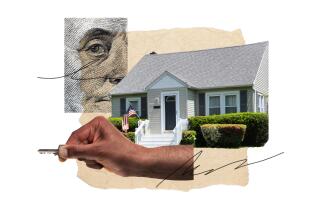Racial Balance Proves to Be an Elusive Goal for Suburban Communities
TEANECK, N.J. — The real estate agent told George Powell that the owner of the four-bedroom, two-bath house on which he had made a bid was taking it off the market.
Powell, a Philip Morris executive with a wife and three children, was suspicious for two reasons: He is black and the owner of the house was dead.
Welcome to the suburbs, Mr. Powell.
George Powell was the exception--he fought back. He sued the real estate agent and a local open-housing group picketed the house. Finally, the Powells became Teaneck residents.
That was 20 years ago. Today, the Powells are still exceptional: They live on an integrated street in an integrated suburb--an environment that is still beyond the reach of most black Americans.
The exclusion of blacks was part of the foundation of American suburbia. Leases in Levittown, N. Y., the largest and best known postwar housing tract, limited occupants to “members of the Caucasian race.”
If he admitted blacks, William Levitt insisted, whites wouldn’t buy. “It was a question of economics,” he later said. “We can’t take on the functions of the government.”
Although 12% of Americans are black, only 6% of all suburbanites are black.
But between 1970 and 1980, the last full decade for which statistics are available, the black share of suburban population increased 40%. Some of the most famous suburbs--Oak Park and Park Forest, Ill., and Shaker Heights, Ohio--have growing black communities.
Purdue University sociologist John Stahura says that blacks “are suburbanizing at a faster pace than whites. There’s a pent-up black demand for suburban housing.”
Stahura also said that blacks tend to wind up in the older, larger and poorer communities that are closest to the cities and often seem more urban than suburban. One extreme example is Ford Heights, a predominantly black community of 5,300 south of Chicago.
Ford Heights always was more industrial than residential, and when industry left, unemployment soared past 50%. An annual per capita income of $4,943 makes Ford Heights the nation’s poorest suburb, according to one survey.
The town has sought to attract the kinds of employers most suburbs fight to keep out: a fireworks factory, a state prison, a garbage incinerator.
Outside of such poverty pockets, suburban blacks generally enjoy a higher standard of living than their city cousins. There is one constant, however: segregation.
Block-by-block studies have found that suburbs are just as segregated as the cities: 25 of the nation’s 300 largest metropolitan areas contain about three-fifths of all black suburbanites.
Moreover, history suggests that an “integrated” suburb is probably a former all-white suburb in the process of becoming all black.
Although Oak Park and Shaker Heights have devised intricate strategies to maintain racial balance, they are doomed to fail, Stahura said. Both communities, he said, are surrounded by predominantly black neighborhoods and will become black, middle-class communities themselves.
So far, this has not happened in Teaneck, a town of 37,000 near the bridge between northern New Jersey and New York City. The median house price is around $260,000 and the racial mix (64% white, 24% black, the rest Asian, Latino and others) approximates that of greater New York.
Teaneck prides itself on its racial and ethnic diversity. A former mayor, who is black, calls it a “community of communities.” This idea dates back to 1954, when the Army designated Teaneck--which then had several black families--a model town worthy of emulation by the subjugated Germans and Japanese.
When blacks started moving into northeastern Teaneck in increasing numbers, some white families were quick to sell. Other whites posted “Not for Sale” signs on their lawns and passed an ordinance to stop real estate agents from stampeding owners into selling. In 1964, Teaneck became the first community in the nation to use busing to integrate its schools voluntarily.
But even in Teaneck, there is a limit to integration.
George Powell says he often is the only black at a wedding or funeral, and his contact with most of his neighbors extends only to an occasional wave.
“There is educational integration and there is residential integration but there isn’t social integration,” he said.
“There are two separate societies,” he added. “It’s a matter of choice. The races work together and live together, but don’t play together.”
More to Read
Inside the business of entertainment
The Wide Shot brings you news, analysis and insights on everything from streaming wars to production — and what it all means for the future.
You may occasionally receive promotional content from the Los Angeles Times.










